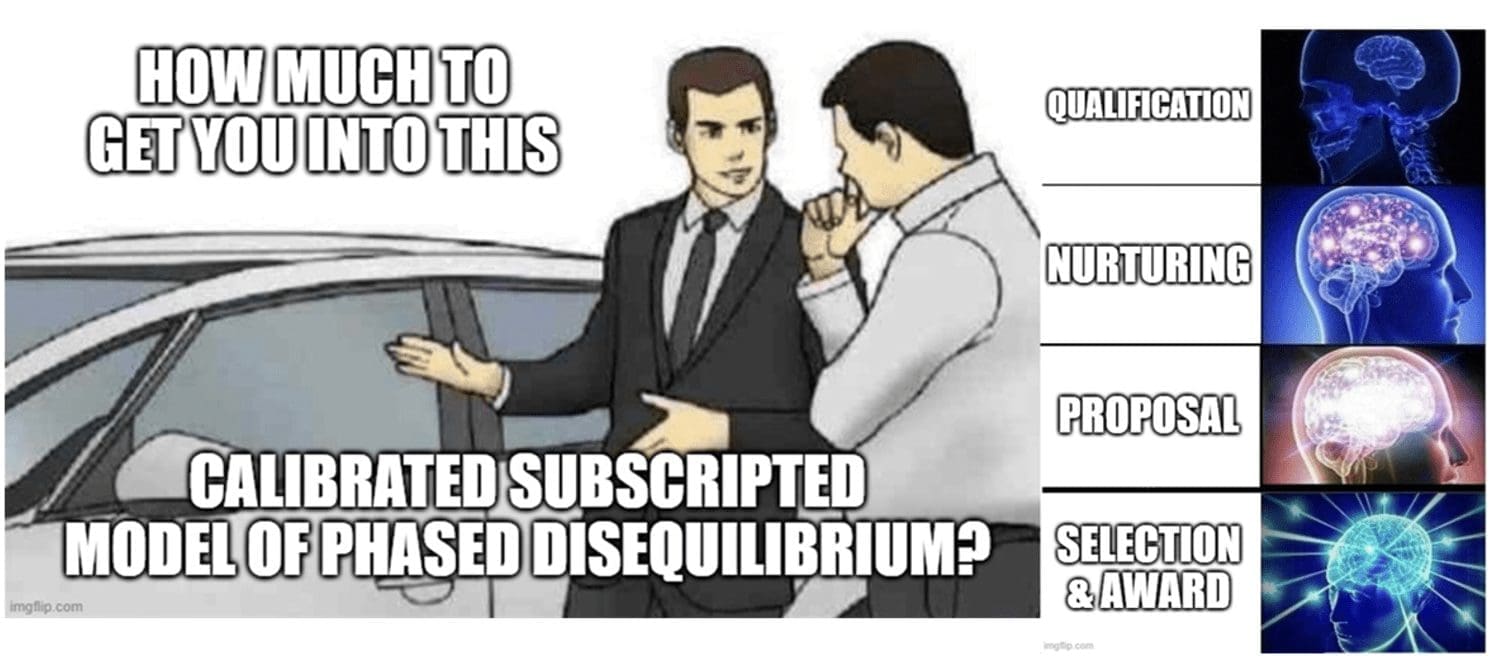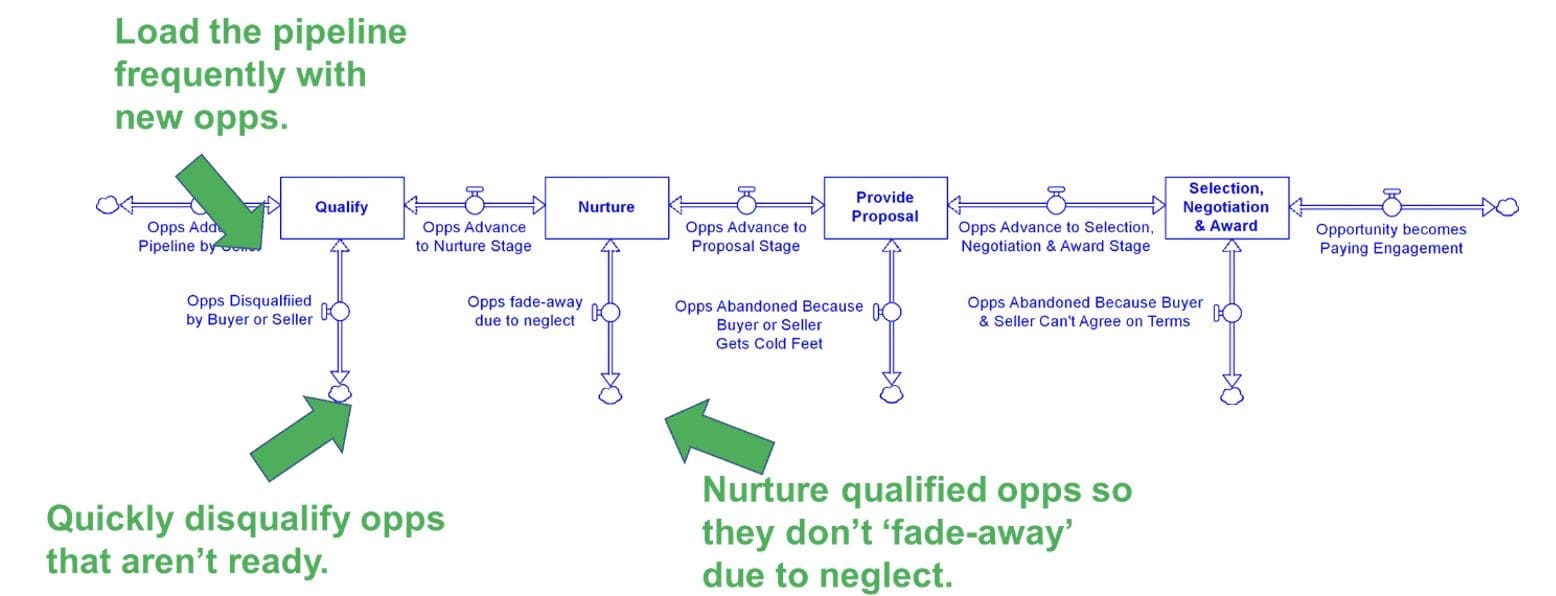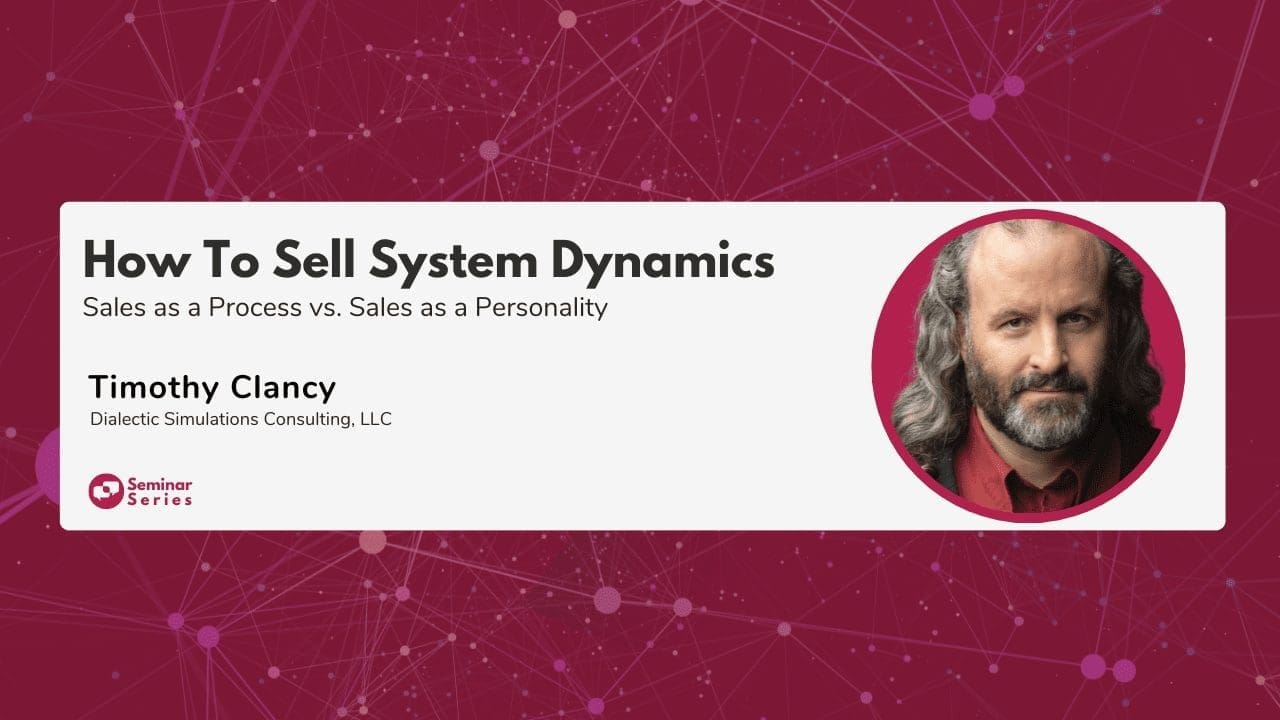How to Sell System Dynamics (Or Anything Else)
If it’s so good – why is System Dynamics so hard to sell?
The key to selling System Dynamics has nothing to do with what we’ve learned in grad school. Instead, the key is to clarify a fundamental confusion everyone seems to have. When you ask people what makes business development successful they’ll often respond “sales is about personality.” Instead, it should be, “sale is a process.”
Watch the webinar recording on this topic.

This guide is designed for startups, early-career contractors, or other practitioners slogging through the business development cycle of landing system dynamics contracts. Additionally, the concept and application of a sales pipeline is transferable to other applications of system dynamics: grad school or grant applications, employment pursuits, and even publication.
In this article, I cover the basics of a sales pipeline; the difference between sales as a personality vs. sales as a process; and how to use the sales pipeline with added tips and tricks.
What is a Sales Pipeline?
A major confusion that practitioners have about selling technical work is the belief that business development is personality versus a process. I thought that myself for years – that to be “good at sales” was like being good at math. You were either born with the skills or you weren’t.
Sales, however, is a process. The structure of selling as a system is depicted in this simplified aging chain.

The units of measure moving through the aging chain are “Opportunities” (Opps) which represent a potential sale. But opportunities only become a sale in the final outflow of the stock on the far right. Along the way, opportunities either advance along the pipeline to the next stage or get abandoned for various reasons. Structurally speaking both outflows can serve a purpose.
“Knowing which stage an opportunity is in is important, you can’t just take it for granted it will always begin at the left even though most will.”
You want good opportunities to move to the right along the aging chain and opportunities that aren’t ready to move out through the abandonment downwards. Note that all flows are bi-flows. Opportunities may move back and forth horizonally and sometimes abandoned deals re-enter the pipeline back in the same stage they were. I’ve provided a proposal on an opportunity that went cold and was abandoned because the circumstances weren’t right. Years later the buyer sent me an email with the proposal asking if it was still valid. Circumstances had changed. This is why knowing which stage an opportunity is in is important, you can’t just take it for granted it will always begin at the left even though most will.
Learning to see sales as a process through an aging chain provides immediate insights. At each stage, there’s a natural abandonment rate – regardless of personality or salesmanship. What this means is that selling as a process is a numbers game that operates as a process. The more you put in at the left and work the process through the stages, the more you’ll have come out the right.
If it helps, think of the aging chain as a series of ratios and drivers:

This is notional but it illustrates a few key aspects of the ratio and drivers. First, if the ratio is 30:1 from opportunities to engagement and you want to have at least one engagement – do you have 30 opportunities in your pipeline? If you want two engagements, do you have 60? If you’re on a paying engagement that is about to end and you haven’t filled your pipeline with 30 more potential opportunities, where’s your paycheck going to come from?
This “feast or famine” effect is particularly hard for small firms where both selling and delivering are done by the same person. This sales pipeline is also useful for fields other than private-sector business sales. The sales pipeline, ratio, and drivers also apply to non-business uses. Whether you’re pursuing employment, grants, or other opportunities you’ll move through some version of these stages.
“Everything we learned about first-order control, unit dimensionality, and truth & beauty in models only ever gets a chance to shine if first, we have exercised other skills”
The only stage where our technical knowledge of System Dynamics arises is during the proposal. Everything we learned about first-order control, unit dimensionality, and truth & beauty in models only ever gets a chance to shine if first, we have exercised other skills: qualifying and nurturing opportunities to get them to the point of being able to submit a proposal. The value prop of a proposal matters a lot too, but that’s a different blog post.
Stages of the Sales Pipeline – Sellers Perspective:
In this simplified seller’s perspective, the stages of the four stages of the pipeline are:
- Qualifying
- Nurturing
- Proposing
- Selection & Negotiation
Entire books can be written about any one of these – but to get started here are some simple definitions.
Qualifying: This stage is about evaluating opportunities to ensure they have the potential to reach the final stage. This means, at minimum, determining the potential buyer(s) have:
- A clear problem they need to solve.
- A budget with which to solve it.
- The authority to use that budget and grant a contract award.
- A timeline in which they want to start the work.
Nurturing: Nurturing consists of two things: first, identifying concerns, questions, or barriers a buyer might have and addressing them. This not only builds confidence in the buyer but gives you insights into the proposal. Second: keeping in regular positive contact. Be proactive on this. End every meeting with a review of what concerns, questions, or barriers you’re going to resolve next and confirm the timeline and schedule of decision-making. If a buyer hasn’t responded – politely nudge them on a regular basis. If you no longer think a buyer is serious – find out by asking “is now not the right time, and if not when might be?” You don’t want to spend time chasing deals that won’t happen.
Proposing: Congratulations! All that work has paid off and you finally get to put your best foot forward in providing a proposal. Proposals usually consist of both technical and financial elements. And if you’ve done a good job qualifying and nurturing the opportunity through the pipeline the proposal should almost write itself. How you will solve their problem, address any concerns that came up, and show how you’ll deliver the results they seek.
Selection & Negotiation: The work isn’t over when you hit send on the proposal! There may be clarifying questions, request for a demonstration, or additional details. Selection & Negotiation is a lot like nurturing – find out what the barriers to selection are and manage them while keeping positive regular contact with the buying team.
Tips for Selling as a Process with Pipeline Development
Numerous books and blogs give advice on how to work on pipeline development. But when you’re just beginning, there are three tips I’d suggest starting with based on my own experience over the years:
1. Don’t mistake the opportunity stage you’re in.

2. Don’t spend too much time on unqualified opportunities vs. developing qualified ones.

3. Managing the pipeline efficiently:
- Load new opportunities frequently.
- Disqualify opportunities that aren’t ready quickly
- Nurture qualified opportunities through development.

Resources for Sales Pipeline
Just as there are many books and website posts about the sales pipeline – lots of people will try and sell you fancy tools. You become an opportunity in their pipeline! But ask yourself – if you’re not already getting that notional 30 opportunities loaded that lead to one sale; do you really need a fancy tool? At Dialectic, for five years now we’ve managed our sales pipeline on a simple google sheet and we’ve attached a free copy available through Google Sheets.
Closing
Selling System Dynamics work – whether to a private business, government research, or finding a faculty posting – requires many elements. But one thing it doesn’t require is a sales personality. Understanding selling as a process and using a sales pipeline to manage that process helps immensely.
I’m always happy to network and exchange ideas – so if you need help on the sales pipeline or any aspect of developing System Dynamics as a business offering feel free to drop me a line at timc@dialecticsims.com or hit me up on Twitter @DialecticSims or @InfoMullet. Be sure to say hi and let me know if you appreciate this post or if there are other topics you’d like to hear about. And don’t forget to bookmark the System Dynamics Society Practitioners Blog!
Watch the recording below
Want to know more about How to Sell System Dynamics? Watch the recording below!
In this webinar, Timothy Clancy clarifies how selling System Dynamics is less about having a sales personality than it is about following a process known as a sales pipeline. This seminar is designed for startups, early-career contractors, or other practitioners slogging through the business development cycle of landing System Dynamics contracts. Additionally, the concept and application of a sales pipeline are transferable to other applications of System Dynamics: grad school or grant applications, employment pursuits, and even publication.
Whoops, this recording is available for members and ticket purchasers only. Please login to verify. If you’re not a member, purchase a membership here.
About the Author
Timothy Clancy (Tim) is the founder of Dialectic Simulations Consulting, LLC a firm focused on delivering systems thinking and simulation capabilities to public, private, and non-profit 500 clients. Tim’s career in consulting spans over 25 years, including 10 years at IBM, where he was deeply involved in both business development and delivery. Tim has a Ph.D. in System Dynamics from WPI.
Recent Posts
Call for Presenters: Seminar Series
Call for Presenters: Seminar Series We at the System Dynamics Society are continually seeking vibrant and knowledgeable presenters for our ongoing Seminar Series. As we unfold the calendar, there’s always a place for more insights, experiences, and expertise to enrich...
Honoring Excellence: A Glimpse into the Awards of the International System Dynamics Conference
Honoring Excellence: A Glimpse into the Awards of the International System Dynamics Conference The International System Dynamics Conference brings together experts, practitioners, and students to exchange ideas, showcase real-world applications, and celebrate...
From Bergen to Global: UiB’s System Dynamics Group
From Bergen to Global: UiB’s System Dynamics Group The System Dynamics Group, an autonomous research group at the University of Bergen (UiB) was established in 1971 by professor emeritus Svein Nordbotten. Inspired by the work of Jay W. Forrester, Nordbotten...
Upcoming Events

MIT System Dynamics Seminar | Work Faster? Put in Longer Hours? An Assessment of Reactive Resilience Policies in Supply Chains
Please visit the MIT System Dynamics Seminars page for more information. You are invited to attend a supplemental System Dynamics seminar being held on Tuesday, April 23rd from 12:00-1:00pm EST in the Jay W. Forrester conference room, E62-450, or via...
Recent Business cases
A Design Value Calculator: A System Dynamics Boardgame
A Design Value Calculator: A System Dynamics Boardgame EXECUTIVE Summary Product design is a specific form of complex innovation that touches all areas of an organization’s management. While entrepreneurs recognise the value of design, they often tend to focus...
The World Bank Uses System Dynamics to Identify Root Causes of Poverty
The World Bank Uses System Dynamics to Identify Root Causes of Poverty EXECUTIVE Summary Madagascar has one of the highest poverty rates in the world. In 2022, an astonishingly three out of every four people in Madagascar lived below the poverty line. Poverty has...
Fast-Track Cities Uses System Dynamics to Enhance HIV Care
Fast-Track Cities Uses System Dynamics to Enhance HIV Care EXECUTIVE Summary Low levels of viral suppression at 69% for people with HIV make it hard to believe the 95% target level will be achieved by 2030 in St. Louis, USA. As a solution, Fast-Track Cities-STL opted...


